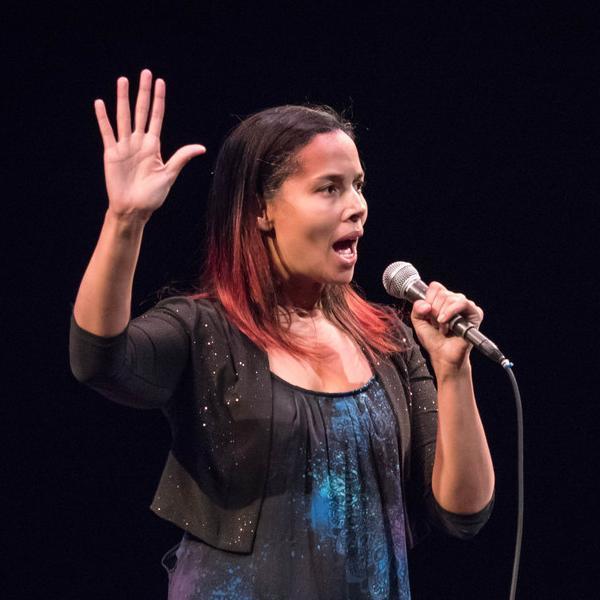
Making Connections Through Music
Rhiannon Giddens brought her passion for music to the classroom, sharing her artistic process of creation and collaboration with students.
By Ally O’Connor ‘20
For a week during October, Grammy-winning singer and musician Rhiannon Giddens shared her talent and vision with students, faculty, and members of the Santa Clara University community. As the 2019-20 Frank Sinatra Chair in the Performing Arts, she spent her Fall Residency visiting classes, engaging with students and faculty, and closed out the week with a live performance in Mayer Theatre.
A classically trained musician, Giddens has pursued a variety of musical styles, finding a home with the broad genre of folk. Her work, which has earned her a prestigious MacArthur Fellowship, seeks to create musical connections between the past and present and bring to light the contributions—many of which have been buried by history—of oppressed people. As she prioritized meeting with students while on campus, she brought this focus to the classroom.
In Nancy Unger’s “U.S. Women’s History” course, Giddens helped bring history to life through her songs. As part of the class discussion on the relationship between white southern women and enslaved women, Giddens spoke about her passion for turning slave narratives and other historical documents into powerful songs. “The first time I heard [Giddens’] “Julie” I became completely unglued,” said Unger. “That song, and “At the Purchaser’s Option,” both of which she played for my students, showed them how profoundly music can bring history to life in ways that no lecture or reading can duplicate.”
In addition to visiting music classes such as “Beginning Music Composition” and “Introduction to Performance Collaboration”, Giddens also met with Danielle Morgan’s “Cultural Studies and Literary Theory” class. To kick off a discussion about how different texts are interpreted, Morgan played Patsy Cline’s “She’s Got You” and then Giddens’ version of the same song. Students had the opportunity to talk about the different interpretations, ask Giddens questions, and learn how her interpretation of the song emerged.

“[It was] amazing to hear about [Giddens’] songwriting and performing process,” says Erika Rasmussen ’20 (English). She talked about how much she's changed since the making of that [version], which is such a cool glimpse into the way that art changes as we change, and how artists grow and transform.”
Not only was Giddens “warm and willing to discuss her songwriting process and the way she was able to interpret someone else's lyrics,” says Morgan, but she conveyed her passion for music and history through their discussion and clearly resonated with the students.
Giddens “doesn't usually write about herself, but chooses to write the stories of other people,” explained Rasmussen. “Her immersion in reckoning with the suffering of slavery and its continued damage and destruction carries such deep emotion. She talked about how much she reads, how she digs into history, and I'm just blown away by the intentionality and passion of her work. It's not just about her, she's really bringing centuries of history to the forefront of her music.”

At the culmination of her week of class visits, Giddens performed there is no Other with Francesco Turrisi in Mayer Theatre to a crowd of excited students, faculty, and community members. Enjoying the performance thoroughly, faculty member Kirk Glaser (English) notes that "what impresses me about [Giddens] is this beautiful poetic voice delivering a message of historical suffering that is still so alive. Her voice offers hope in the face of that ongoing challenge.” Rasmussen, who also attended the concert, poignantly shares that her performance was “a piece of art that spoke to everyone in the audience in its own way. The night was a history lesson, it moved the soul, it connected people across cultures.”
Her performance was a piece of art that spoke to everyone in the audience in its own way. The night was a history lesson, it moved the soul, it connected people across cultures.